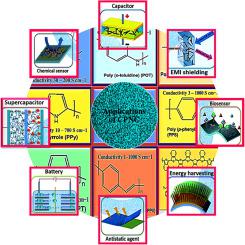Synthetic Metals ( IF 4.0 ) Pub Date : 2021-01-04 , DOI: 10.1016/j.synthmet.2020.116674 Christopher Igwe Idumah

|
Conducting polymer composites (CPCs) have been versatily utilized in actualizing advanced devices such as supercapacitors, biosensors, photovoltaic cells, batteries, catalysts, chemical sensors, and so on. Conducting polymer nanocomposites (CPNCs) are derived from hybridization of intrinsically conductive polymers (CPs) with inorganic entities thereby fabricating multifunctional materials with enhanced performances. Conducting polymer bionanocomposites (CPBs) are electrically conducting biocomposites derived from mixing of CPs with biopolymers such as proteins, cellulose, guar-gums, chitosan, chitin, gelatin, and so on, resulting in emancipation of CBs for use in biomedical, agricultural and food engineering due to attainment of biocompatibility, biodegradability, and electrical conductivity. Therefore, this paper presents recently emerging trends in synthesis, characterization, and properties of CP composites, nanocomposites, bionanocomposites, and applications.
中文翻译:

导电聚合物纳米复合材料和生物纳米复合材料的新趋势
导电聚合物复合材料(CPC)已被广泛用于实现高级设备,例如超级电容器,生物传感器,光伏电池,电池,催化剂,化学传感器等。导电聚合物纳米复合材料(CPNC)来源于固有导电聚合物(CPs)与无机实体的杂化,从而制造出性能增强的多功能材料。导电聚合物生物纳米复合材料(CPBs)是通过将CPs与生物聚合物(例如蛋白质,纤维素,瓜尔胶,壳聚糖,几丁质,明胶等)混合而得到的导电生物复合材料,从而释放出用于生物医学,农业和食品的CB由于获得了生物相容性,生物降解性和电导率,因此可以进行工程设计。因此,











































 京公网安备 11010802027423号
京公网安备 11010802027423号